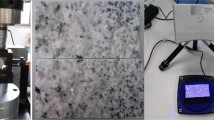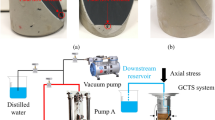Abstract
In deep tunnelling, mining and subsurface energy recovery, the reliable estimate of rough fracture (or fault) strength and the potential for reactivation are of vital importance for the assessment of dynamic geo-hazard, such as fault slip rock-burst and induced earthquakes. In this study, true triaxial loading tests were conducted on pre-fractured granite with different orientations to the maximum principal stress, and the fracture slip process was studied with the aid of acoustic emission and deformation monitoring. The reactivation strength was also compared with the theoretical predictions based on the analytical model. Results show that the critical fracture angle for the rock matrix failure and original macro-fracture reactivation is ~ 51°, above which fault slip occurs along the original macro-fracture at a gradually smaller differential stress. The microscopic analysis indicates that new faulting develops traversing the original fracture which becomes more compacted and closed with insignificant damage when the fracture angle is below ~ 44°. The differential stress required for rough fracture reactivation is well predicted by the single plane of weakness theory. In addition, variation of acoustic emission signals (especially AE energy) and deformation along σ3 direction with loading time are very consistent, which can be used to analyse the preparatory and evolutionary process of the fracture reactivation. The stress rate decreases whilst deformation rate increases both from a steady state value to a very large value as the fracture is gradually reactivated, accompanied by the b value decreasing from 1.4–2 to 0.4–0.6, which can be used as precursors for the dynamic fault slip. The findings in the present study will provide new insights into the mechanics of rough fracture reactivation in deep tunnelling, mining and underground resource extraction.
Highlights
-
True triaxial loading tests are conducted on pre-fractured granite with different fracture orientations to the maximum principal stress.
-
Three different failure modes are revealed for pre-fractured granite specimens with increasing fracture angles from 39° to 57°.
-
The original macro rough fracture is reactivated when the fracture angle is above ~50°.
-
The obtained fracture reactivation strengths are very consistent with the theoretical prediction by the single plane of weakness theory.
-
Acoustic emission hits (counts) and deformation along σ3 are effective indicators to show the preparatory process before fracture reactivation.

















Similar content being viewed by others
Availability of Data and Material
Not applicable.
Code Availability
Not applicable.
References
Amitrano D (2012) Variability in the power-law distributions of rupture events: how and why does b-value change. Eur Phys J Spec Top 205(1):199–215
Boettcher MS, Marone C (2004) Effects of normal stress variation on the strength and stability of creeping faults. J Geophys Res: Solid Earth. 109(B3).
Byerlee J (1978) Friction of rocks. Rock friction and earthquake prediction. Birkhäuser Basel, Basel, pp 615–626
Cai W, Zhu H, Liang W (2022) Three-dimensional stress rotation and control mechanism of deep tunneling incorporating generalized Zhang-Zhu strength-based forward analysis. Eng Geol 308:106806
Cochran ES, Skoumal RJ, McPhillips D, Ross ZE, Keranen KM (2020) Activation of optimally and unfavourably oriented faults in a uniform local stress field during the 2011 Prague, Oklahoma, sequence. Geophys J Int 222(1):153–168
Cui G, Zhang C, Ye J, Zhou H, Li L, Zhang L (2022) Influences of dynamic normal disturbance and initial shear stress on fault activation characteristics. Geomech Geophys Geo-Energy Geo-Resour 8(5):159
Dang W, Konietzky H (2022) The effect of normal load oscillation amplitude on the frictional behavior of a rough basalt fracture. Rock Mech Rock Eng 55(6):3385–3397
Dang W, Konietzky H, Frühwirt T, Herbst M (2020) Cyclic frictional responses of planar joints under cyclic normal load conditions: laboratory tests and numerical simulations. Rock Mech Rock Eng 53:337–364
Dang W, Chen J, Huang L (2021) Experimental study on the velocity-dependent frictional resistance of a rough rock fracture exposed to normal load vibrations. Acta Geotech 16:2189–2202
Diederichs MS, Kaiser PK, Eberhardt E (2004) Damage initiation and propagation in hard rock during tunnelling and the influence of near-face stress rotation. Int J Rock Mech Min Sci 41(5):785–812
Duan K, Ji Y, Xu N, Wan Z, Wu W (2019) Excavation-induced fault instability: possible causes and implications for seismicity. Tunn Undergr Space Technol 92:103041
Eberhardt E (2001) Numerical modelling of three-dimension stress rotation ahead of an advancing tunnel face. Int J Rock Mech Min Sci 38(4):499–518
Feng GL, Feng XT, Chen BR, Xiao YX, Yu Y (2015) A microseismic method for dynamic warning of rockburst development processes in tunnels. Rock Mech Rock Eng 48:2061–2076
French ME, Zhu W, Banker J (2016) Fault slip controlled by stress path and fluid pressurization rate. Geophys Res Lett 43(9):4330–4339
Giorgetti C, Violay M (2021) The influence of loading path on fault reactivation: a laboratory perspective. Geophys Res Lett 48(8):e2020GL091466
Giorgetti C, Tesei T, Scuderi MM, Collettini C (2019) Experimental insights into fault reactivation in gouge-filled fault zones. J Geophys Res: Solid Earth 124(4):4189–4204
Gomberg J, Schulz W, Bodin P, Kean J (2011) Seismic and geodetic signatures of fault slip at the Slumgullion Landslide Natural Laboratory. J Geophys Res: Solid Earth. 116(B9).
Hayward KS, Cox SF (2017) Melt welding and its role in fault reactivation and localization of fracture damage in seismically active faults. J Geophys Res: Solid Earth 122(12):9689–9713
Husen S, Kissling E, von Deschwanden A (2012) Induced seismicity during the construction of the Gotthard Base Tunnel, Switzerland: hypocenter locations and source dimensions. J Seismolog 16:195–213
Jaeger JC (1959) The frictional properties of joints in rock. Geofis Pura Appl 43:148–158
Jaeger JC (1960) Shear failure of anistropic rocks. Geol Mag 97(1):65–72
Ji Y, Wu W (2020) Injection-driven fracture instability in granite: mechanism and implications. Tectonophysics 791:228572
Ji Y, Wanniarachchi WAM, Wu W (2020) Effect of fluid pressure heterogeneity on injection-induced fracture activation. Comput Geotech 123:103589
Karner SL, Marone C (2000) Effects of loading rate and normal stress on stress drop and stick-slip recurrence interval. Geocomplexity and the physics of earthquakes, vol 120. American Geophysical Union, Washington, pp 187–198
Kleepmek M, Khamrat S, Thongprapha T, Fuenkajorn K (2016) Displacement velocity effects on rock fracture shear strengths. J Struct Geol 90:48–60
Leeman JR, Saffer DM, Scuderi MM, Marone C (2016) Laboratory observations of slow earthquakes and the spectrum of tectonic fault slip modes. Nat Commun 7(1):1–6
Li S, Feng XT, Li Z, Zhang C, Chen B (2012) Evolution of fractures in the excavation damaged zone of a deeply buried tunnel during TBM construction. Int J Rock Mech Min Sci 55:125–138
Manouchehrian A, Cai M (2018) Numerical modeling of rockburst near fault zones in deep tunnels. Tunn Undergr Space Technol 80:164–180
Mei C, Barbot S, Wu W (2021) Period-multiplying cycles at the transition between stick-slip and stable sliding and implications for the Parkfield period-doubling tremors. Geophys Res Lett 48(7):e2020GL091807
Meng F, Zhou H, Wang Z, Zhang L, Kong L, Li S, Zhang C (2016) Experimental study on the prediction of rockburst hazards induced by dynamic structural plane shearing in deeply buried hard rock tunnels. Int J Rock Mech Min Sci 86:210–223
Meng F, Wong LNY, Zhou H, Yu J, Cheng G (2019) Shear rate effects on the post-peak shear behaviour and acoustic emission characteristics of artificially split granite joints. Rock Mech Rock Eng 52:2155–2174
Ortlepp WD (2000) Observation of mining-induced faults in an intact rock mass at depth. Int J Rock Mech Min Sci 37(1–2):423–436
Rehbock-Sander M, Jesel T (2018) Fault induced rock bursts and micro-tremors–Experiences from the Gotthard Base Tunnel. Tunn Undergr Space Technol 81:358–366
Rinaldi AP, Urpi L (2020) Fault reactivation induced by tunneling activity in clay material: Hints from numerical modeling. Tunn Undergr Space Technol 102:103453
Sainoki A, Mitri HS (2014a) Dynamic behaviour of mining-induced fault slip. Int J Rock Mech Min Sci 66:19–29
Sainoki A, Mitri HS (2014b) Dynamic modelling of fault-slip with Barton׳ s shear strength model. Int J Rock Mech Min Sci 67:155–163
Scaringi G, Hu W, Xu Q, Huang R (2018) Shear-rate-dependent behavior of clayey bimaterial interfaces at landslide stress levels. Geophys Res Lett 45(2):766–777
Sibson RH (1974) Frictional constraints on thrust, wrench and normal faults. Nature 249(5457):542–544
Sibson RH (1985) A note on fault reactivation. J Struct Geol 7(6):751–754
Sibson RH (1990) Rupture nucleation on unfavorably oriented faults. Bull Seismol Soc Am 80(6A):1580–1604
Streit JE, Hillis RR (2004) Estimating fault stability and sustainable fluid pressures for underground storage of CO2 in porous rock. Energy 29(9–10):1445–1456
Wang JC, Wang ZH, Yang J, Tang YS, Li BB, Meng QB (2020a) Mining-induced stress rotation and its application in longwall face with large length in kilometer deep coal mine. J China Coal Soc 45(3):876–888
Wang L, Kwiatek G, Rybacki E, Bohnhoff M, Dresen G (2020b) Injection-induced seismic moment release and laboratory fault slip: Implications for fluid-induced seismicity. Geophys Res Lett 47(22):e2020GL089576
Wang F, Xia K, Yao W, Wang S, Wang C, Xiu Z (2021) Slip behavior of rough rock discontinuity under high velocity impact: experiments and models. Int J Rock Mech Min Sci 144:104831
Wu W (2021) A review of unloading-induced fault instability. Underground Space 6(5):528–538
Wu W, Zhao Z, Duan K (2017) Unloading-induced instability of a simulated granular fault and implications for excavation-induced seismicity. Tunn Undergr Space Technol 63:154–161
Xiao YX, Feng XT, Hudson JA, Chen BR, Feng GL, Liu JP (2016) ISRM suggested method for in situ microseismic monitoring of the fracturing process in rock masses. Rock Mech Rock Eng 49:343–369
Xu NW, Tang CA, Li LC, Zhou Z, Sha C, Liang ZZ, Yang JY (2011) Microseismic monitoring and stability analysis of the left bank slope in Jinping first stage hydropower station in southwestern China. Int J Rock Mech Min Sci 48(6):950–963
Xu NW, Li TB, Dai F, Zhang R, Tang CA, Tang LX (2016) Microseismic monitoring of strainburst activities in deep tunnels at the Jinping II hydropower station, China. Rock Mech Rock Eng 49:981–1000
Ye Z, Ghassemi A (2018) Injection-induced shear slip and permeability enhancement in granite fractures. Journal of Geophysical Research: Solid Earth 123(10):9009–9032
Zhang C, Feng XT, Zhou H, Qiu S, Wu W (2012) Case histories of four extremely intense rockbursts in deep tunnels. Rock Mech Rock Eng 45:275–288
Zhang C, Xu J, Jin S, Cui G, Guo Y, Li L (2022) Sliding modes of fault activation under constant normal stiffness conditions. J Rock Mech Geotech Eng. 15(5):1213–1225
Zhou H, Meng F, Zhang C, Hu D, Yang F, Lu J (2015) Analysis of rockburst mechanisms induced by structural planes in deep tunnels. Bull Eng Geol Env 74:1435–1451
Acknowledgements
We gratefully acknowledge financial support from the National Science Foundation of China under Grant Nos. 51879135, 52279116 and 52179114, the National Key Research and Development Program of China (Grant No. 2022YFE0137200) and Taishan Scholars Program (2019KJG002, 2019RKB01083).
Author information
Authors and Affiliations
Contributions
All the authors contribute to this research, and FZM and DWH designed the experiment, FZM, ZFY, MZL, JHH, QJC and WW: conducted the test and analysed the experimental data, FZM: wrote the paper, DWH and CQZ: revised the paper.
Corresponding authors
Ethics declarations
Conflict of Interest
The authors declare that there is no conflict of interest that may affect the research reported in this paper.
Additional information
Publisher's Note
Springer Nature remains neutral with regard to jurisdictional claims in published maps and institutional affiliations.
Rights and permissions
Springer Nature or its licensor (e.g. a society or other partner) holds exclusive rights to this article under a publishing agreement with the author(s) or other rightsholder(s); author self-archiving of the accepted manuscript version of this article is solely governed by the terms of such publishing agreement and applicable law.
About this article
Cite this article
Meng, F., Yue, Z., Li, M. et al. Frictional Sliding Behaviour of Rough Fracture in Granite Under True Triaxial Loading with Implications for Fault Reactivation. Rock Mech Rock Eng 57, 197–217 (2024). https://doi.org/10.1007/s00603-023-03561-3
Received:
Accepted:
Published:
Issue Date:
DOI: https://doi.org/10.1007/s00603-023-03561-3




